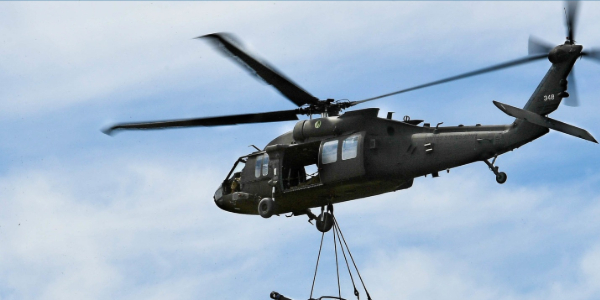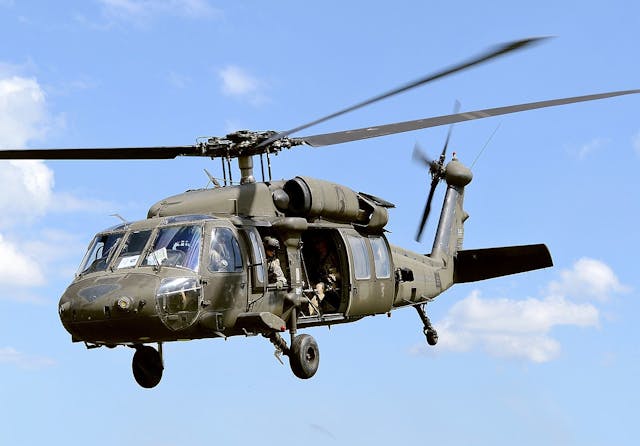UH 60 Helicopter: Advanced Avionics and Fight Solutions
UH 60 Helicopter: Advanced Avionics and Fight Solutions
Blog Article
Discovering the Ingenious Innovation Behind Airplane Style and Design
The area of aircraft layout and design is observing a transformative change driven by cutting-edge modern technologies that boost sustainability, effectiveness, and efficiency. Advanced products such as carbon fiber composites and titanium alloys are setting brand-new requirements, while wind resistant innovations and expert system are enhancing processes and boosting results. As the sector faces the challenges of environmental duty, advancements in lasting aviation modern technologies assure to improve the future. The implications of these innovations expand past performance metrics; they might redefine the actual nature of air traveling. What might this mean for the industry all at once?
Advanced Materials in Airplane Style
Just how can the integration of sophisticated products change aircraft layout? The consolidation of advanced products, such as carbon fiber compounds, titanium alloys, and advanced ceramics, plays an essential function in improving airplane performance and performance.
Furthermore, sophisticated products show boosted resistance to deterioration and tiredness, leading to lower upkeep expenses and prolonged solution life. The usage of titanium in crucial components assists endure extreme temperatures and tensions, while carbon fiber compounds supply adaptability in design and production processes. This flexibility permits more aerodynamic shapes, adding to exceptional performance attributes.
Furthermore, the combination of clever materials, which can change residential properties in feedback to outside stimulations, opens brand-new methods for adaptive systems in airplane design. uh 60. These innovations assure not only to improve safety and security and functional efficiency however also to add to sustainability initiatives by reducing ecological influence with minimized discharges. In summary, advanced materials are redefining the landscape of airplane design, leading the method for more effective, long lasting, and eco-friendly air travel options
Wind Resistant Innovations for Effectiveness
Aerodynamic innovations play a crucial duty in enhancing airplane effectiveness, substantially influencing fuel consumption and overall performance. Advancements in airfoil layout, such as the intro of supercritical wings, enable optimized lift-to-drag proportions, minimizing drag at transonic speeds. These technologies allow aircraft to maintain higher rates with reduced fuel expenditure, straight affecting operational expenses and ecological sustainability.
Moreover, the assimilation of winglets has actually confirmed reliable in reducing vortex-induced drag at the suggestions of wings, better improving gas performance - uh 60. This layout modification results in a decrease in wake disturbance, contributing to boosted aerodynamic efficiency during cruise problems

In addition, computational fluid dynamics (CFD) devices have transformed the testing and refinement of aerodynamic shapes, permitting precise simulations of airflow around airplane (uh 60). This makes it possible for engineers to introduce continuously, making sure that contemporary aircraft not only fulfill governing criteria however also press the borders of effectiveness in aeronautics

Function of Computer Simulations
Computer system simulations have actually come to be an essential device in the area of airplane style, making it possible for designers to perform thorough analyses and optimizations of various layout elements. These simulations enable the online screening of aerodynamic properties, structural stability, and performance metrics long before physical models are developed. By employing computational fluid dynamics (CFD) and limited aspect analysis (FEA), engineers can predict how air streams around the aircraft and exactly how various materials will respond to stress and pressure.
Furthermore, computer simulations promote the exploration of a vast array of scenarios and variables, accelerating the design procedure and lowering expenses connected with physical screening. This capability not just improves the precision of forecasts concerning airplane actions however additionally uses insights right into possible style enhancements that might not be instantly evident through typical methods.

In addition, simulations assist make sure compliance with rigid safety policies by allowing designers to identify and correct potential problems early in the layout phase. The combination of simulation innovations right into the airplane style procedure emphasizes the significant innovations in engineering techniques, inevitably adding to the growth of more secure, extra effective, and eco-friendly airplane.
Artificial Intelligence in Engineering
Expert system (AI) is reinventing the engineering landscape, particularly in airplane style, by maximizing and boosting decision-making procedures layout operations. With equipment discovering algorithms, AI can examine vast datasets, revealing patterns and insights that inform design this content selections and boost general performance.
AI applications in aircraft layout include generative layout, where algorithms produce multiple layout choices based on specified criteria, allowing engineers to evaluate a broader series of possibilities. This not just accelerates the design stage but likewise ensures that the end products meet strict performance and security criteria.
Additionally, AI-driven anticipating analytics help with upkeep organizing by examining historic data and forecasting prospective failures. This positive approach lowers downtime and enhances aircraft dependability.
Additionally, AI help in simulation and modeling, enabling engineers to evaluate layouts under numerous conditions without the requirement for physical models. This ability shortens advancement timelines and lessens costs linked with standard screening approaches.
Lasting Air Travel Technologies
The answer lies in the adoption of lasting aeronautics modern technologies that prioritize efficiency and reduce carbon emissions. Advancements such as lasting aeronautics gas (SAFs), which are derived from sustainable resources, have emerged as a critical part in attaining lower lifecycle discharges.
Moreover, improvements in aircraft layout, such as the advancement of lighter materials and even more aerodynamically reliable shapes, contribute to improved gas efficiency. Electric and hybrid propulsion systems are also acquiring grip, supplying a pathway to decrease reliance on nonrenewable fuel sources and reduce from this source greenhouse gas exhausts.
The integration of these modern technologies is supported by regulatory frameworks and sector cooperations focused on establishing ambitious sustainability targets. Moreover, digital tools like data analytics and synthetic knowledge can optimize trip operations, additionally enhancing gas effectiveness. By welcoming lasting methods and technologies, the aviation industry can not only satisfy the expanding demand for flight yet also play a critical official source duty in dealing with environment adjustment, guaranteeing a more lasting future for air transportation.
Conclusion
The convergence of innovative materials, wind resistant advancements, and cutting-edge modern technologies notes a substantial advancement in airplane style and design. The assimilation of carbon fiber composites, titanium alloys, and AI-driven processes not only boosts performance and performance yet likewise simplifies operations and predictive upkeep. The ongoing advancement of sustainable aviation technologies highlights a dedication to environmental obligation, leading the way for a greener future in air travel. This constant technology will certainly form the industry's trajectory for years ahead.

Computer simulations have actually become a vital device in the field of aircraft style, making it possible for designers to carry out detailed analyses and optimizations of various style elements.The merging of innovative materials, aerodynamic developments, and cutting-edge modern technologies marks a significant development in airplane layout and engineering.
Report this page